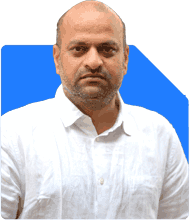Ramalingam Kalirajan |10870 Answers |Ask -Follow
Mutual Funds, Financial Planning Expert - Answered on Jun 25, 2024
He has an MBA in finance from the University of Madras and is a certified financial planner.
He is the director and chief financial planner at Holistic Investment, a Chennai-based firm that offers financial planning and wealth management advice.... more

Hi guru, My wife is pregnant now, expected delivery is on aug and the amount of delivery is around 2 lacks in Hyderabad. We both are corporate employees and holding corporate insurances, mine can be claimed upto 50k and my wife insurance can be claimed upto 70k As i came to know that we both cannot be submitted for cashless claim, Questions: Can we pay the total amount by cash and claim individual insurances by submitting the hospital bills? Can we go a head with my wife cashless claim for 70k and remaining bills can be submitted in my company insurance? Whats the best procedure to claim the both our corporate insurance benefits? Please suggest. Note: recently my friend submitted their both corporate maternity bills and has been claimed.
Understanding Corporate Insurance Coverage
Cashless Claims and Reimbursement
Corporate health insurance typically offers two main methods of claim settlement: cashless and reimbursement. Cashless claims allow direct billing to the insurance provider, whereas reimbursement requires you to pay upfront and later get reimbursed by submitting bills.
Your Specific Insurance Coverage
You mentioned that your insurance covers up to Rs. 50,000 and your wife’s insurance covers up to Rs. 70,000. This is a good start, but since the total estimated cost is around Rs. 2 lakh, careful planning is needed to utilize both insurance benefits effectively.
Claiming Through Cashless Facility
Using Your Wife’s Cashless Claim
One option is to use the cashless claim facility of your wife's insurance for Rs. 70,000. This simplifies the process as you won’t need to arrange this amount upfront.
Remaining Amount for Reimbursement
For the remaining Rs. 1.3 lakh, you can submit the bills for reimbursement under your insurance and your wife's insurance. Let's explore this in more detail.
Step-by-Step Claim Process
Step 1: Contact Both Insurance Providers
Before the delivery, contact both of your insurance providers to confirm the procedures for cashless claims and reimbursements. Confirm that you can indeed use the cashless claim for Rs. 70,000 under your wife’s policy and the reimbursement process for the remaining amount under both policies.
Step 2: Cashless Claim Submission
Pre-authorization: Ensure you get pre-authorization for the cashless claim under your wife’s policy. This usually involves submitting a form provided by the insurance company along with a doctor’s recommendation and estimated hospital bill.
During Admission: At the hospital, submit the pre-authorization approval and your wife's insurance card to avail of the cashless facility up to Rs. 70,000.
Step 3: Payment for Remaining Amount
After utilizing Rs. 70,000 through the cashless facility, you will need to pay the remaining Rs. 1.3 lakh out of pocket at the hospital.
Step 4: Collect Detailed Bills and Discharge Summary
Make sure you collect all the original bills, payment receipts, and a detailed discharge summary from the hospital. These documents are crucial for the reimbursement process.
Step 5: Reimbursement Claim Submission
Your Insurance: Submit the original bills and discharge summary to your insurance provider to claim Rs. 50,000.
Wife’s Insurance: Submit the remaining bills (after Rs. 70,000 cashless claim) to your wife’s insurance provider for reimbursement up to Rs. 70,000. Since her total coverage is Rs. 70,000, and if you've already used that for cashless, this step may not be necessary unless the insurance allows combining both cashless and reimbursement within the limit.
Step 6: Follow Up
Regularly follow up with both insurance providers to ensure that your claims are processed promptly. Keep copies of all submitted documents for your records.
Maximizing Insurance Benefits
Coordinate With HR Departments
Sometimes, corporate insurance policies have specific guidelines. Coordinate with your respective HR departments to understand any nuances or additional benefits that might be available.
Seek Clarification on Policy Terms
Ensure you clearly understand the terms of both policies, especially concerning maternity coverage, as there might be specific clauses or additional benefits not immediately apparent.
Use of Top-Up Plans
If available, consider any top-up plans or additional maternity benefits that might cover the extra amount. Some corporate policies offer add-ons that can be particularly useful in situations like this.
Real-Life Example
Your friend managed to claim from both corporate maternity benefits. This is encouraging and suggests that with proper documentation and adherence to procedures, it is possible. Ask your friend for specific details about the process they followed, as it can provide valuable insights.
Final Insights
Handling maternity expenses with corporate insurance requires strategic planning. By using the cashless facility for your wife’s insurance and submitting reimbursement claims for both policies, you can maximize your coverage.
Ensure to get all pre-approvals, maintain detailed records, and stay in regular contact with both insurance providers. This proactive approach will help you navigate the process smoothly and ease the financial burden during this joyous time.
Best regards,
K. Ramalingam, MBA, CFP
Chief Financial Planner
www.holisticinvestment.in
You may like to see similar questions and answers below
Sanjib Jha | Answer |Ask -Follow
Insurance Expert - Answered on Jun 21, 2022
Ramalingam Kalirajan |10870 Answers |Ask -Follow
Mutual Funds, Financial Planning Expert - Answered on Apr 16, 2024
Ramalingam Kalirajan |10870 Answers |Ask -Follow
Mutual Funds, Financial Planning Expert - Answered on Jun 18, 2024
Milind Vadjikar | Answer |Ask -Follow
Insurance, Stocks, MF, PF Expert - Answered on Sep 29, 2024
Milind Vadjikar | Answer |Ask -Follow
Insurance, Stocks, MF, PF Expert - Answered on Feb 16, 2025
Dr Dipankar Dutta |1837 Answers |Ask -Follow
Tech Careers and Skill Development Expert - Answered on Dec 05, 2025
Dr Shyam Jamalabad |108 Answers |Ask -Follow
Dentist - Answered on Dec 05, 2025
Dr Shyam Jamalabad |108 Answers |Ask -Follow
Dentist - Answered on Dec 05, 2025
Dr Shyam Jamalabad |108 Answers |Ask -Follow
Dentist - Answered on Dec 05, 2025
Dr Dipankar Dutta |1837 Answers |Ask -Follow
Tech Careers and Skill Development Expert - Answered on Dec 05, 2025
Ulhas Joshi |280 Answers |Ask -Follow
Mutual Fund Expert - Answered on Dec 05, 2025
Dr Dipankar Dutta |1837 Answers |Ask -Follow
Tech Careers and Skill Development Expert - Answered on Dec 04, 2025
Ravi Mittal |676 Answers |Ask -Follow
Dating, Relationships Expert - Answered on Dec 04, 2025
Anu Krishna |1745 Answers |Ask -Follow
Relationships Expert, Mind Coach - Answered on Dec 04, 2025
Anu Krishna |1745 Answers |Ask -Follow
Relationships Expert, Mind Coach - Answered on Dec 04, 2025





























